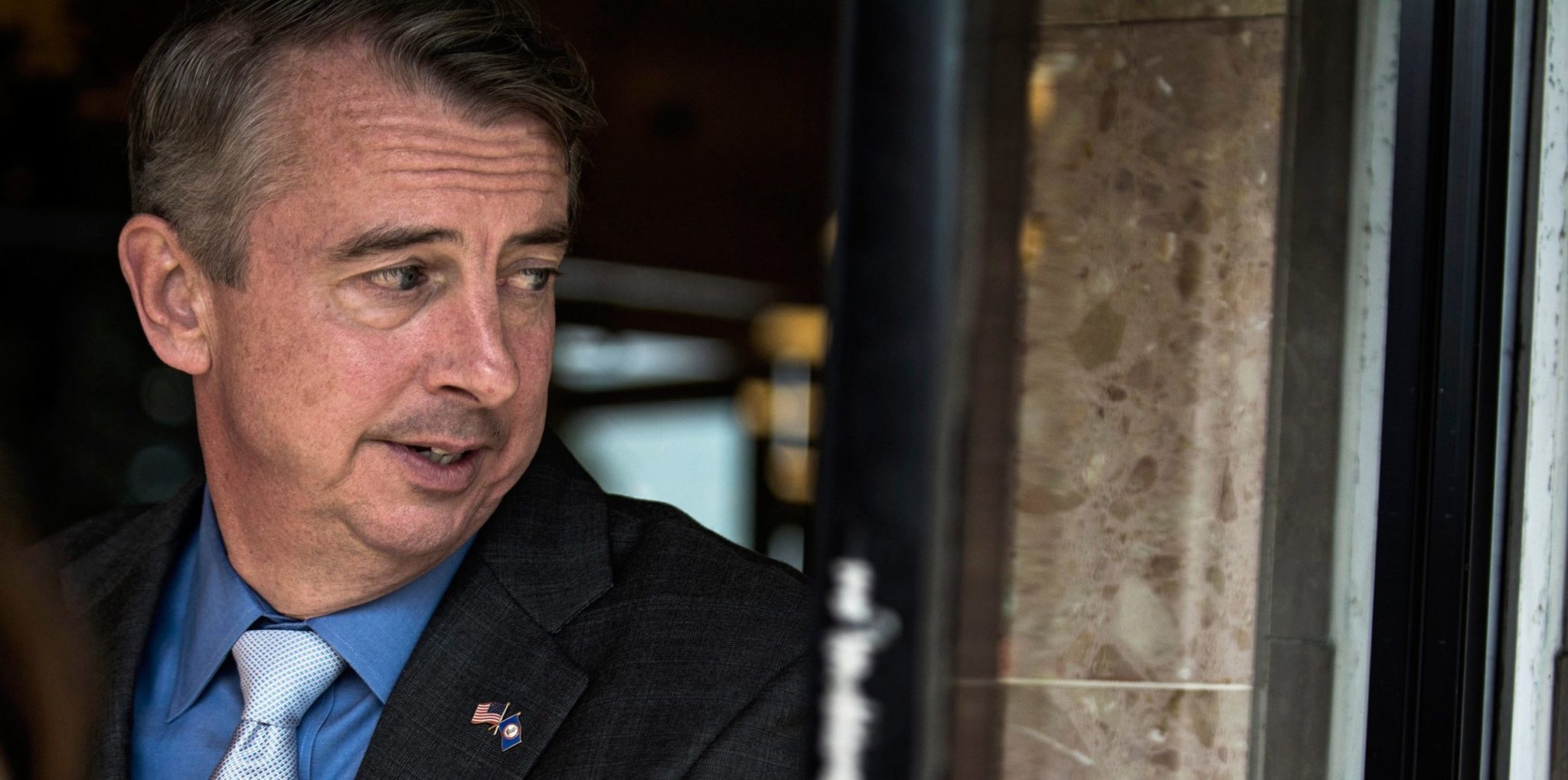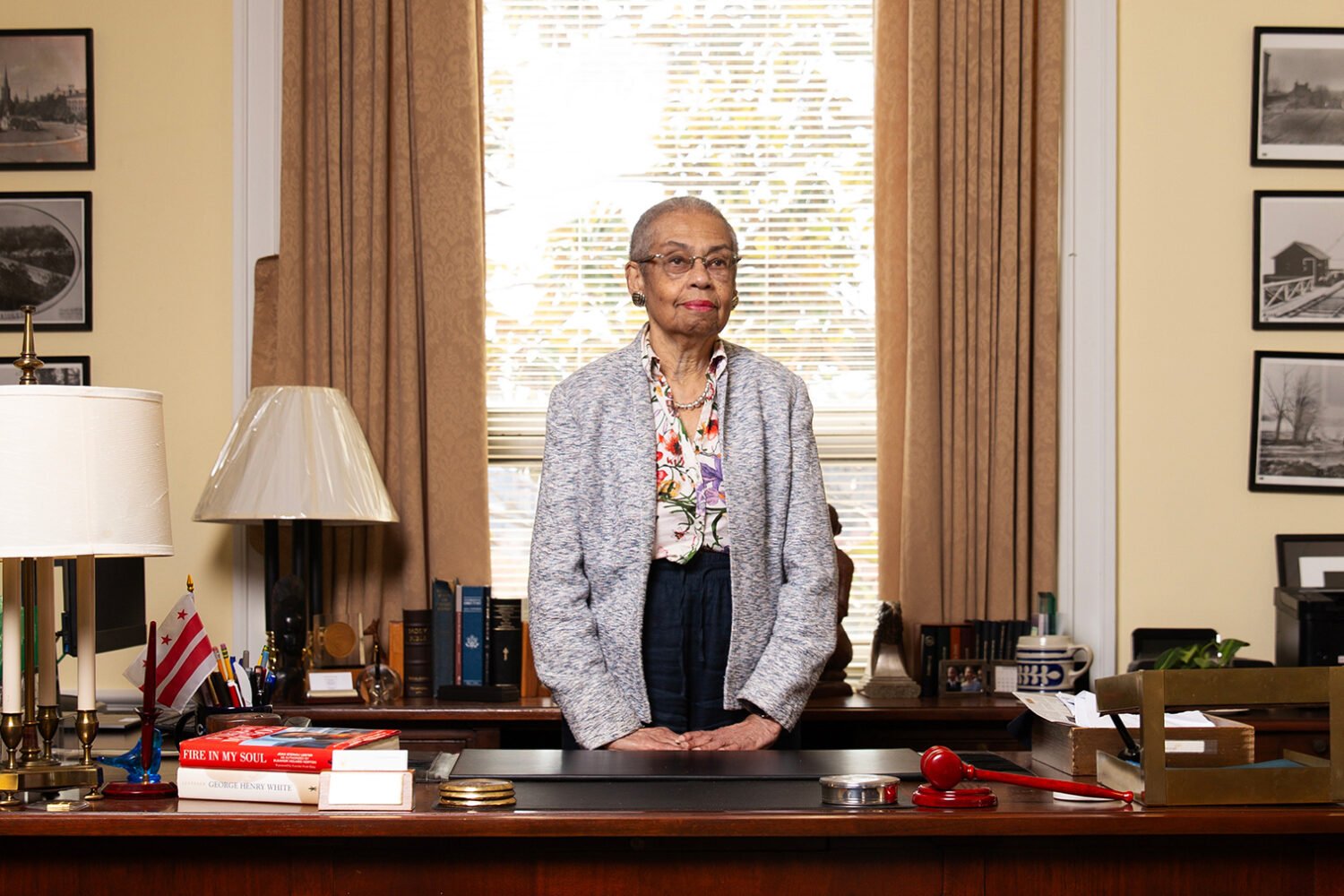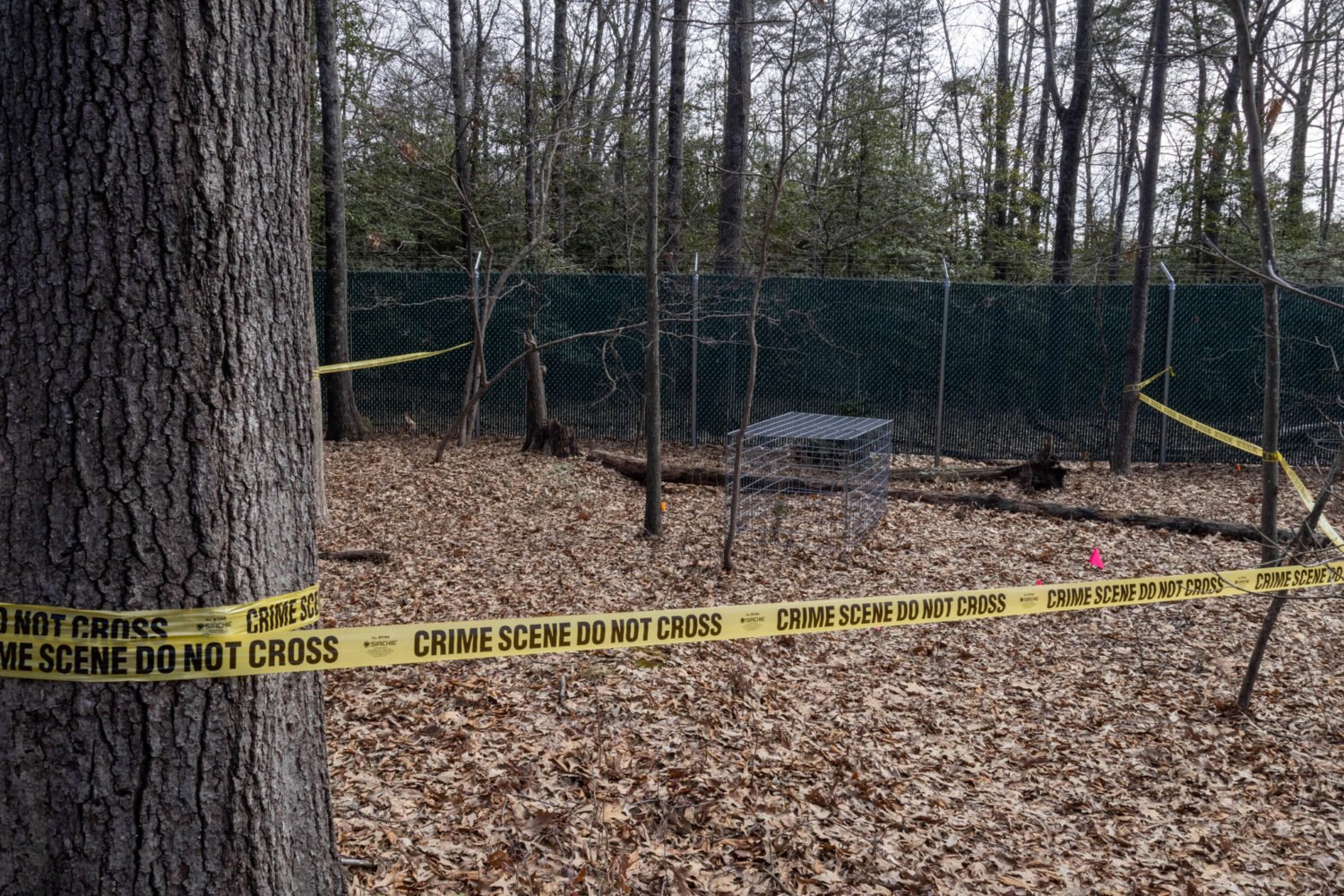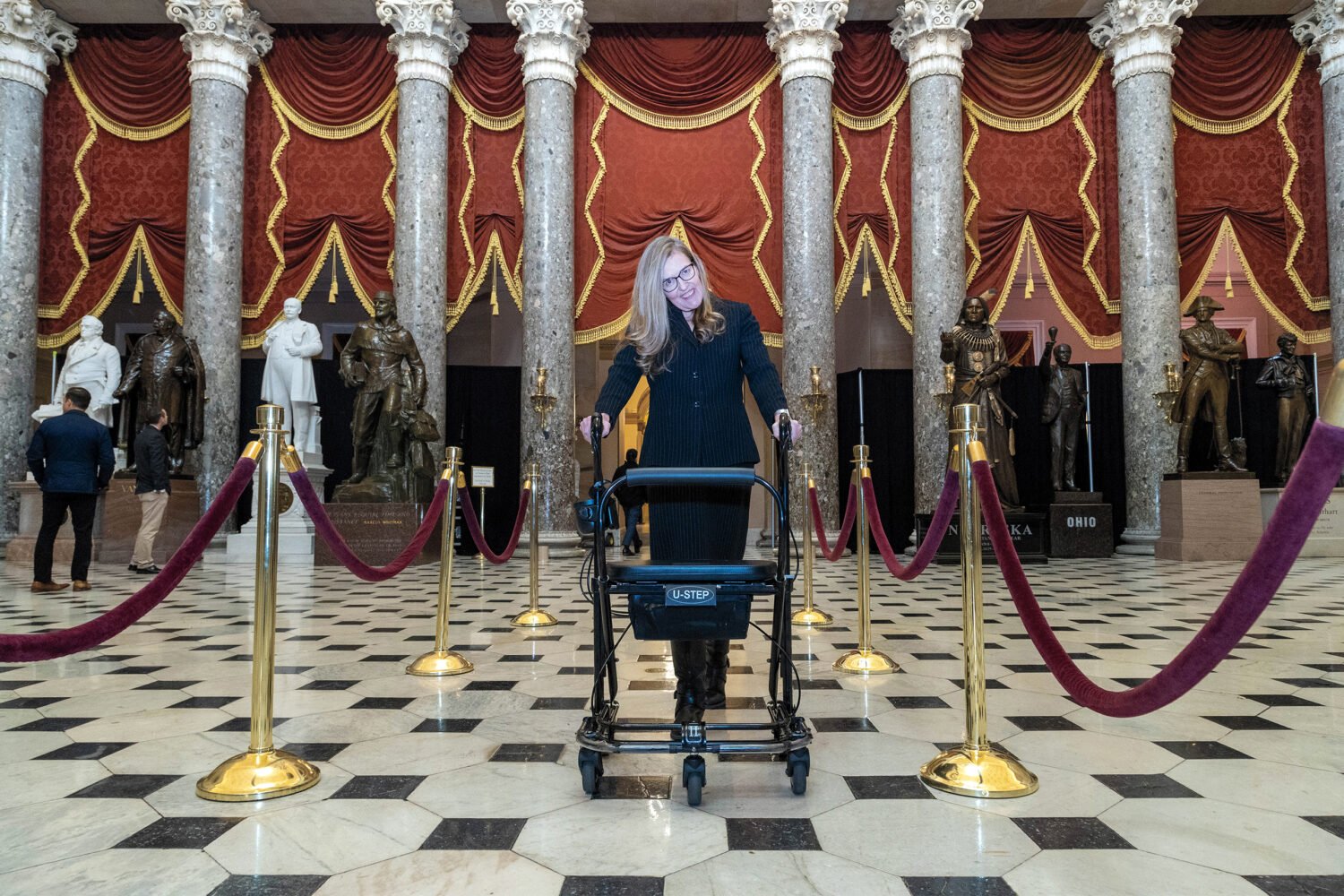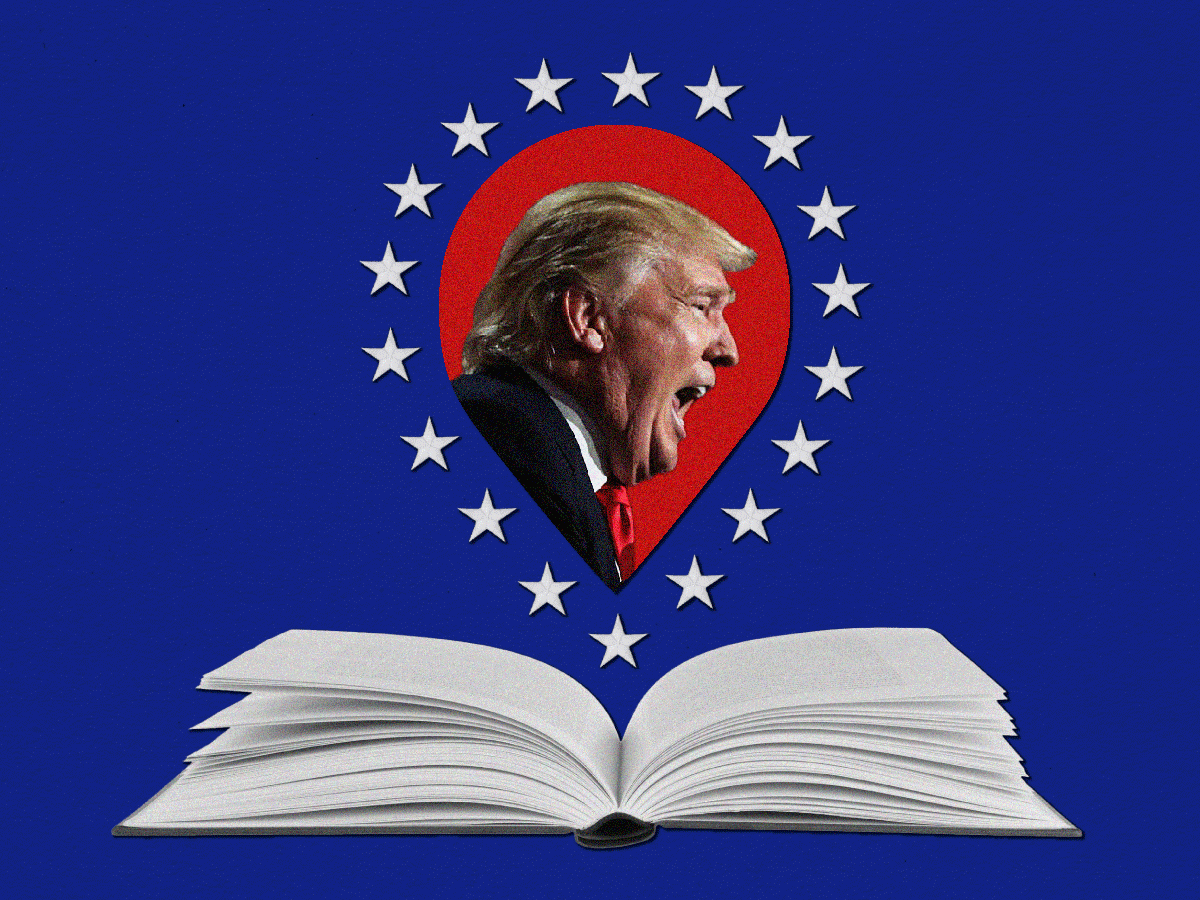It’s a muggy afternoon in early summer, and Ed Gillespie is making a lunchtime stop at Mission BBQ, a military-themed chain restaurant in a strip-malled stretch of the Fairfax County exurbs. Arriving with no entourage other than his driver, Gillespie walks to the register and orders a brisket sandwich with French fries. He attracts no attention and, after a hasty nosh, begins to greet customers. His go-to move is to say hello, drop off a brochure, promise he’ll be a good governor, and skedaddle, usually in less than 15 seconds. Occasionally, he’ll pull off an ad-lib. One man wishes him luck, and Gillespie riffs that his father, who immigrated from County Donegal as a kid, used to say, “There’s no sense in being Irish if you’re not lucky.” Then he laughs—a kind of staccato wheeze—and moves on. Sometimes he’ll remember to plug a detail about his personal life: “I’m just wondering if I could leave a little information with you. My wife, Cathy, and I will be celebrating 30 years, and there’s some more about policy on my website.” The scene suggests a B-movie alien sweetly trying to blend in on planet Earth.
Gillespie’s slogan is “For All Virginians.” He’s apparently taken it to heart because he really does have different answers for different voters, depending on what he thinks they want to hear. At one table, he encounters a 67-year-old African-American woman named Yasmin Harris, who asks him how he plans to create job opportunities for recent graduates. By diversifying the state’s economy, he tells her: “We’re too reliant on federal contracts here, we’re too reliant on military spending in Hampton Roads, too reliant on coal in southwest Virginia.”
Sounds sensible. A minute or two later, though, he meets two blond mothers who support Donald Trump. “I voted for him, and I want him to succeed in creating jobs and keeping the country safe,” Gillespie says. Then he Trumpishly outlines a position that almost directly contradicts what he just told Harris. “You know, when you look at Virginia on things like building more ships in Newport News and stopping the war on coal in southwest Virginia and keeping Norfolk the largest naval base in the world and allowing us to develop our oil and gas resources off our deep-sea coast, I want to work with him on those things.”
At 56, Ed Gillespie is among the most influential Republican operatives of his generation. If speed-dial were still a thing, three decades of GOP A-listers would be on his. In another time and place—a Virginia that may no longer exist—his brand of establishment conservatism and professional-political-class style might have been enough to get him to the executive mansion, even accounting for his campaign-trail shtick. Three years ago, when he came within a few thousand votes of the US Senate, the safe route certainly seemed like the best route.
But now, all of a sudden, it’s the age of Trump, and Gillespie represents a caricature of all that the President and his supporters vowed to eradicate from politics: a Beltway insider who enriched himself working at the nexus of government and big business. Gillespie isn’t just a creature of the “swamp.” He helped invent it.
During the Republican primary, Gillespie barely defeated Prince William County supervisor Corey Stewart, whose impish, cynical campaign was premised almost entirely on combating illegal immigration and defending Confederate monuments. A couple of months later, when a white-supremacist rally in Charlottesville culminated in deadly violence, the darker impulses behind Stewart’s candidacy became scarily tangible. Gillespie’s response to Charlottesville—he supports efforts to put Confederate statues “in the proper historical context” but not to remove them—was characteristically measured, nuanced, and thoroughly unsuited to the state’s emotional temperature.
If Charlottesville underscored Gillespie’s limitations as a candidate, the tragedy also served as a reminder of what’s at stake for Virginia’s Republicans on November 7. The state represents the first major electoral battleground of the Trump era. What was thought to be a referendum on the President may also test the deeper currents of the state. As a lifelong government courtier and DC transplant—like the current governor—Gillespie would seem to embody the demographic trends of Virginia, whose growth has been driven by government dollars and the professional classes they attract. Yet while the state’s Democratic voters continue to prefer mainstream types able to curry favor with Washington, Republicans—many of them disconnected from the new money of Northern Virginia—increasingly crave a more radical polity.
Win or lose, Gillespie may represent the last gasp of staid, stable, mainstream, and not utterly insane Republicanism in the Commonwealth of Virginia.
It’s not a new phenomenon when a Beltway fixture develops sudden urges to run for office in Virginia. Former governor Chuck Robb worked as a White House social aide to President Lyndon Johnson and married LBJ’s daughter before cultivating his own political career in Richmond. Barbara Comstock rose through the apparatchik economy—Hill staffer, oppo researcher, press flack, lobbyist—before entering the Virginia House of Delegates and the US Congress. Then, of course, there’s Terry McAuliffe, a.k.a. the Macker, a prodigious fundraiser and party hack who glad-handed his way to the governorship in 2013 after a failed try four years earlier.
Ed Gillespie is unique not because he rose to prominence in Washington but because he arguably shaped it more than anyone else currently working in politics. Gillespie grew up middle class in New Jersey, where his parents owned a small grocery store. He arrived in DC to attend Catholic University, graduating four years after McAuliffe, then worked his way through a series of grunt jobs on Capitol Hill before landing a position as press secretary for Texas freshman representative Dick Armey in 1985.
“What always impressed me about Ed in the world of political communications was he was a policy wonk,” says former George W. Bush press secretary Ari Fleischer. “It made him one of the superior staffers on the Hill.”
In those days, it was Gillespie who ran with the right-wing insurgents. In 1992, he helped Armey unseat California moderate Jerry Lewis from the House Republican Conference, which soon became a stronghold for Armey, Gingrich, and the rest of the rising congressional right. In 1994, Gillespie was a lead author of the Contract With America, which catapulted the rebels into power.
Inevitably, Gillespie outgrew Capitol Hill. “After one meeting,” he wrote in his 2006 book, Winning Right: Campaign Politics and Conservative Policies, “it occurred to me that the person urging me to look favorably on a certain bill probably made twice what I was making. It dawned on me that I could make more money knowing Ed Gillespie than I was making being Ed Gillespie.”
In another time and place, Gillespie’s brand of establishment conservatism might have been enough to get him to the executive mansion. But that Virginia may no longer exist.
He became a lobbyist, left briefly to work on Bush’s 2000 presidential campaign, then returned to lobbying. His firm, Quinn, Gillespie & Associates, built a portfolio of dozens of gold-plated clients (Microsoft, DaimlerChrysler, Louis Vuitton) and some less-than-reputable ones (Enron). The ease with which he pushed his bosses’ agendas—whoever they happened to be—made him the ultimate team player. In 2003, Gillespie was named chairman of the Republican National Committee, and in 2007 he became White House counselor to Bush. Later, he joined Karl Rove to create American Crossroads, the first major super-PAC of the Citizens United era. He mingled as easily with the culture warriors of the ’90s as he did with Bush’s band of corporatist conservatives. “He certainly succeeded on the inside, and because of that, he also gives very good advice on the outside,” says former Texas senator Kay Bailey Hutchison.
Quietly, Gillespie began to lay the groundwork for a potential campaign of his own. In late 2006, he accepted a surprise position as unpaid chairman of the Virginia Republican Party, professionalizing a factional and dysfunctional organization. A couple of years later, he was back to chair Bob McDonnell’s gubernatorial campaign, helping turn the candidate, as one Democratic operative put it, from “the chief Bible-thumper in the House of Delegates to a suburban dad at the Fairfax County PTA meeting.” Gillespie coined McDonnell’s campaign slogan, “Bob’s for Jobs,” and worked to broaden the party tent. McDonnell ended up scoring endorsements from a handful of key Democrats and persuaded former governor Doug Wilder to withhold his support from Democratic candidate Creigh Deeds.
As Citizen Gillespie became more involved in local politics, Operative Gillespie was pushing political-warfare innovations whose dramatic successes would, eight years later, complicate his own electoral ambitions.
In 2009, Gillespie took over the Republican State Leadership Committee (RSLC), a previously low-rent fundraising vehicle designed to trickle money down to sleepy state-level races. With his executive director, a Richmond consultant named Chris Jankowski, he devised a more ambitious plan. Once a decade, after the national census was taken, congressional lines are redrawn. Many state legislatures, in turn, can gerrymander those lines for partisan gain. Gillespie realized that the road to a lasting House Republican majority ran through the states: Flip the state legislatures, control the US Congress. Gillespie called it the Redistricting Majority Project: REDMAP.
In his hands, the outfit raised more than $30 million in 2010, helping turn legislatures red in Ohio, Florida, Wisconsin, North Carolina, Michigan, and elsewhere—winning an unprecedented 680 new seats in local-yokel races that never make the national news. Jankowski and Gillespie then deployed staffers to statehouses across the country to physically redraw district maps. By 2012, the results of the mass gerrymandering were obvious: Democrats won 1.4 million more votes than Republicans at the congressional level yet didn’t even get close to flipping the House. REDMAP was Gillespie’s greatest triumph yet.
“I think it was really effective—we won a lot of Republican majorities in a lot of chambers,” he says, clearly proud. “Those are the rules, we played by them, and I played by them pretty effectively.”
That’s especially true in Virginia, where, since 2009, RSLC has poured $9 million into local races, helping solidify GOP control in the House of Delegates and flipping the state Senate. It also helped Gillespie make friends. In 2013, a full $2.8 million went into state senator Mark Obenshain’s unsuccessful race for state attorney general. Since then, Obenshain, a Shenandoah Valley powerbroker, has become Gillespie’s lead ally, bequeathing him a campaign manager, Chris Leavitt, and a broad network of grassroots conservatives. In 2014, Gillespie rode anti-Obama sentiment to a near upset of US senator Mark Warner.
Within two years, however, it seemed Gillespie’s project had succeeded all too well. Emboldened by its new majorities, and safely gerrymandered in GOP strongholds, the party was lurching into wild, uncharted political territory.
Over the last decade, Virginia has mirrored a national trend. While the state has grown more liberal overall, its conservative pockets have become more rabid. Gillespie lives in a waterfront home in a wealthy cul-de-sac in Mount Vernon. In 2000, nine of Mount Vernon’s 21 voting precincts, including Gillespie’s, voted for George W. Bush. In 2008, 4 of 26 voted for John McCain. In 2016, none voted Republican at all. Meanwhile, the GOP-led legislature is increasingly dominated by far-right ideologues. Since taking office, McAuliffe has vetoed 120 pieces of legislation, a record. Among them are bills designed to roll back absentee voting, to make it easier for businesses to discriminate against LGBTQ customers, to allow for weapons to be carried in state office buildings, and to protect Confederate monuments—precisely the sorts of thing that don’t play well in the cul-de-sacs of Northern Virginia. The legislature has also refused to expand Medicaid under the Affordable Care Act.
And this was mostly before Trump—who won the Virginia primary but lost the state in the general election—took office. The new administration has made it harder still to maintain the old marriage between Virginia’s activist right (who can rail against Washington with the best of them) and its business-class GOP (who know that the swamp juices 30 percent of the state economy). Not so long ago, a GOP hopeful could parry claims that he was a corporate-interest hireling by dismissing them as the rantings of collectivist liberals. But now those attacks can come just as easily from the President’s base.
“Ed Gillespie is the swamp,” says Dave ‘Mudcat’ Saunders, who advised former Democratic US senators John Edwards and Jim Webb and sprang for Trump last year. “He’s worked for every bad industry there is.”
During the GOP primary, Gillespie’s past made him a target for Stewart, who, despite having been fired as chairman of Trump’s Virginia campaign, expertly aped his style and drew in his supporters. Stewart was entertaining—like Trump, he blurted out what the rest of the political class was murmuring privately. Gillespie, he said, was avoiding Trump as if the President “had typhoid”—and, moreover, needed to lose his “dorky Mister Rogers” sweater. But Stewart also ran an ugly, mendacious campaign.
“Gillespie is a failed candidate, an anti-Trump K Street lobbyist, who backs amnesty, is OK with late-term abortions, and liberal cities taking down Robert E. Lee and forcing transgender bathrooms,” read a typical campaign spot. (In fact, Gillespie opposes late-term abortions except in cases of rape or incest. On immigration, he has in the past endorsed a path to residency—though not citizenship—for certain illegal immigrants. Finally, he signaled he was opposed both to transgender bathrooms and to removing Confederate statues but downplayed the issues, saying localities should decide.)
Pros dismissed Stewart as a gadfly. Gillespie chose not to engage. Gillespie’s campaign chairman, Pete Snyder, told me, “It doesn’t make any sense for him to be participating in Republican-on-Republican crime, right? It doesn’t fit the bio.”
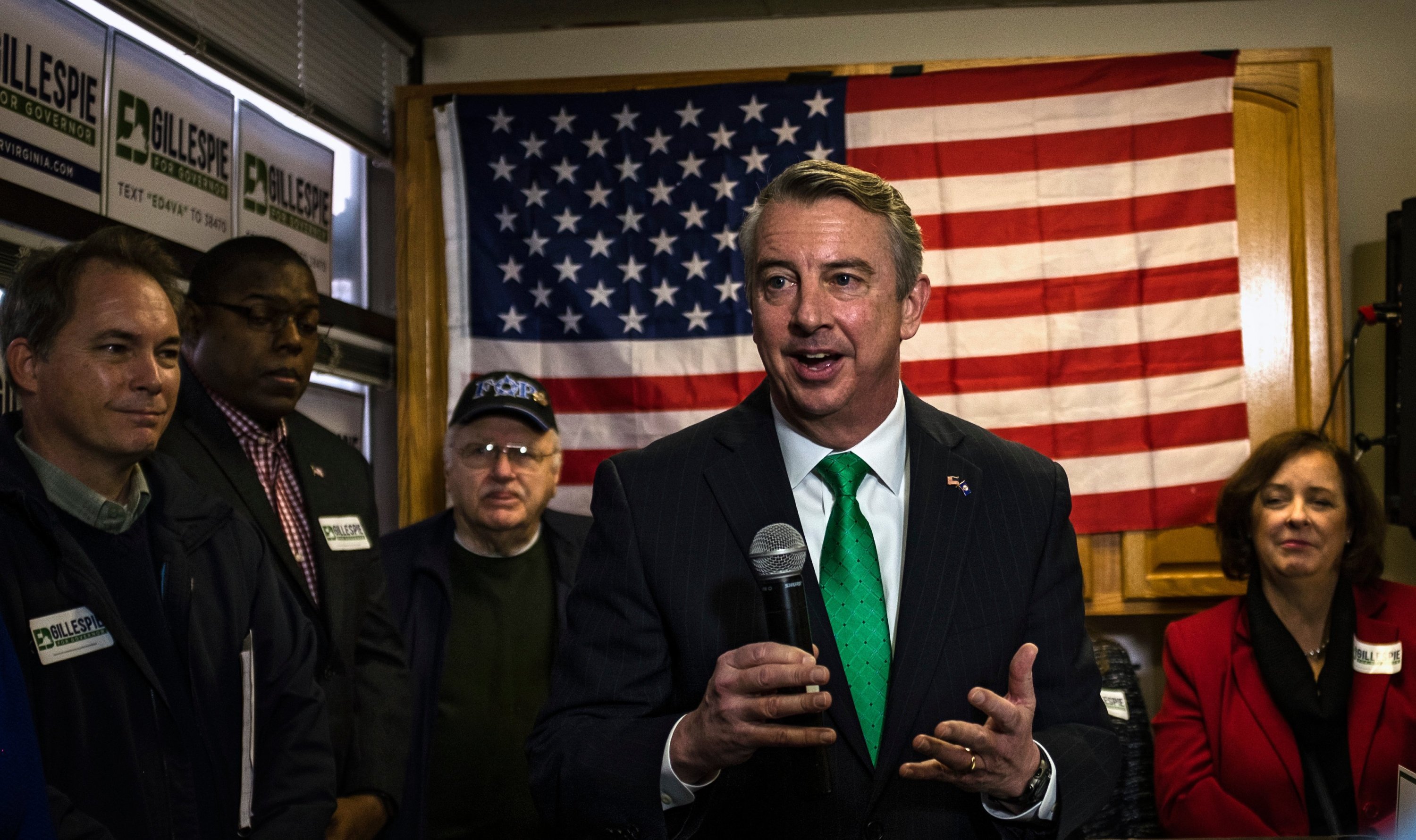
The day of the primary vote, I attended a Gillespie watch-party at a Hilton in suburban Richmond. Gillespie was up in nearly every poll by at least 15 points, and the mood was relaxed. Early in the evening, I encountered a thirtysomething DC lobbyist who had driven down from the NoVa suburbs to support his candidate. “It’s never been a better time to be a swamp-ass,” he said happily, summing up the first six months of the Trump administration. Gillespie, presumably, would keep the pump primed. He predicted a big win.
But as the night wore on, a big win refused to materialize. Polls were closing across the state, and Stewart, incredibly, remained within a few thousand votes of Gillespie. Horrified partygoers stopped talking to one another and began to refresh their phones. In the lobby, a scrum of middle-school Gillespie fans bowed their heads to pray. At 10:07, young Gillespie staffer Tucker Obenshain, daughter to Mark, bounded onstage to announce that “Ed’s about to come out.” Ed did not come out. After another false start, a woman standing on a chair gave up and clambered down. “Oh, my God,” she said, “why do they keep doing this to me?”
Around 10:30 pm, the AP at last called the race for Gillespie. His margin of victory was just over 1 percent. Supporters hooted gamely when Gillespie finally emerged, flush-faced, wearing a kelly-green tie. But the implications were bleak. On the one hand, nativist dog-whistling and Trumpian name-calling had almost undone the GOP’s prohibitive favorite. On the other hand, anti-Trump sentiment helped turn out nearly twice as many Democrats as Republicans for their primary. Once he was onstage, Gillespie’s first impulse was to thank his donors and joke sheepishly that he hadn’t spent a dollar more of their money than he needed to. The whole thing felt, as one Gillespie adviser put it, like a “kick in the nuts.”
On June 29, a little more than two weeks after the primary, a meeting was brokered at the Eisenhower Executive Office Building in Washington that helped bring Gillespie closer to Trumpworld. White House political director Bill Stepien was in attendance, as were Gillespie campaign manager Chris Leavitt, Virginia GOP chairman John Whitback, and a number of party activists from across the state. Press secretary Sean Spicer, then still employed by Trump, stopped by. The meeting was called to brief the White House on the political situation in Virginia, including Gillespie’s campaign. Whitbeck says a number of attendees made the case to Team Gillespie that hard-right voters could be persuaded to fall in line. “I thought there’d be some that said, ‘Ed’s not going to get Stewart voters.’ But we didn’t hear that,” he says. “The most striking thing I can remember was the attitude that ‘Ed has to earn their vote.’ ”
He’s like some dainty old lady who doesn’t want to get her hands dirty. If he continues to stay above the monuments debate, he will lose the election.
Republican politicians typically tack to the center during general campaigns. But Gillespie, the ultimate establishment pol, has done the opposite, stressing the kind of talk-radio issues he once tried to finesse. In his first debate with Democratic nominee Ralph Northam, Gillespie pledged to ban so-called sanctuary cities from the state—even though there technically aren’t any in Virginia. For a while, a pinned tweet on Gillespie’s feed urged cooperation with “federal authorities to stop MS-13.” (“Bob’s for Jobs” it ain’t.) He ripped Northam for being anti-Trump. During a debate, he quoted a polarizing TV spot in which the Democrat had laid into the President. “What are you going to do—call the White House: ‘Please put me through to the narcissistic maniac’?” Gillespie said.
Then came Charlottesville. On August 12, Gillespie was campaigning in southwestern Virginia. That morning, he had released a milquetoast statement condemning “vile hate,” without specifying where it was coming from. Throughout the day, reports of escalating violence started making their way to him. His RV wasn’t getting any satellite radio, and he was trying to check his iPhone for news updates in between campaign stops. When word came that Heather Heyer, a counter-protester, had been fatally struck by a car in the afternoon—an apparent terrorist act—Gillespie stopped campaigning and drove to Charlottesville.
Gillespie quickly distanced himself from Stewart and the neo-Confederate element of his coalition. “[We] reject the people who came in, largely from outside our Commonwealth, and brought their hate, their white supremacism, their neo-Nazism with them,” he told a local NBC reporter. A few days later, after the President infamously equivocated on whom to blame for the rally’s violence, Gillespie told a radio host that there was no moral comparison between white supremacists and “those that show up to condemn them for espousing that kind of hate-filled speech.”
Once again, Gillespie was stuck in an unenviable position. He didn’t go so far as to denounce the President or withdraw his support for Confederate monuments, but he nonetheless drew the ire of his erstwhile tormentor, Stewart, now a US Senate candidate.
“He’s like some dainty old lady who doesn’t want to get her hands dirty,” Stewart said days after the attack. “If he continues to try to stay above the monuments debate, he will lose the election.” In mid-August, Vice President Mike Pence canceled plans to appear at a Gillespie fundraiser in Richmond. A couple of weeks later, Gillespie hired the Trump campaign’s southwestern-Virginia director, a pastor who blamed the anti-monuments push on “communists.”
How Gillespie chooses to define himself—as the operative defending the establishment’s interests or as a reborn avatar of the neo-Confederate wing—will shape the way he governs, should he win on November 7. It’s also possible he won’t choose an identity at all. His cautious malleability, along with his influence-peddling past, makes him an unusually ripe target for oppo researchers. Privately, Republican campaign staffers admit that Northam’s résumé—army vet, pediatric neurologist—beats Gillespie’s in a landslide.
I tried to make the case to the Gillespie camp that he could use some humanizing, that by opening up to a magazine reporter, the winning personality I had heard about from friends might better reveal itself. I didn’t ask for much—a ride-along in the campaign car and maybe a beer afterward—but they didn’t bite. I was granted a 45-minute interview in a Richmond coffee shop, which was subsequently moved to Gillespie’s one-story campaign headquarters outside the capital.
When I arrive, Gillespie is in the bathroom. I occupy myself by looking at the walls. There’s a photo of Gillespie and George W. Bush and a framed profile of Gillespie from Capitol File magazine. Besides that, the place is without personality. I try to start with an ice-breaker, asking what kind of music he listens to in the campaign car.
“Generally, the news stations,” he answers. “Flip around between Fox, CNN, and MSNBC. And some ESPN.” No tunes? “Yeah, not really.”
Okay, then.
Later, I attempt an awkward segue between Donald Trump Jr. and Gillespie’s grown children, whom he never mentions and who never appear on the trail. He seems puzzled by the question, eventually answering simply that one of them lives in California and two in New York: “They’re pursuing their own career, and we’re fully supportive of them.” I don’t learn what any of them do for a living but am told the family texts frequently.
Whatever I ask, Gillespie seems determined not to reveal anything about himself that he hasn’t already said publicly. Why did he run? As if in self-parody, he says he was “called to serve.” When I ask why he so often pledges to be an “honest, ethical governor,” he correctly notes that the current governor was at one point investigated by the FBI for a suspicious campaign contribution and that his predecessor was tainted by an ethics scandal. But when I suggest he might also be trying to play down his own swamp-creature past, he returns a blank stare. “I just really want them to know I’ll be an honest, ethical governor,” he says, chuckling.
Thinking of his campaign-trail insistence that he has run a “small business”—this would be his political consulting firm—I press him again.
He remains unmoved: “I think it’s just a way of saying, ‘This is who I am.’”
This article appears in the October 2017 issue of Washingtonian.
